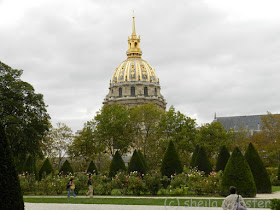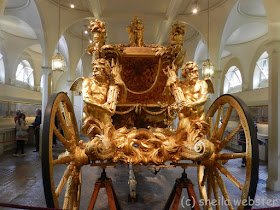We have found, even on our RV travels that when we visit a new city, a tour bus can be the best way to learn our way around and hear a lot of the history. We usually stay on for all of the bus tour to see and then decide where we are going back to. It is nice to have the tour guide information, whether it is with a guide or the prerecorded audio system that many of them are using now.
As with many of the English and European cities, the tour buses are often double deckers with an open top. That would mean you would really appreciate good weather but no matter what, the view is better from up there and so photo's are easier taken from there, too. We were able to purchase a ticket to use anytime within 24 hours, and with that we had a choice of several routes in Paris.Most bus tours allow you to get on and off whenever you wish and that gives you the option to spend more time at any one particular place. We began our tour of Paris from the stop at Tracadero behind the Palais de Chaillot which houses a number of museums. Most of the names on the buildings are in French so we did have some difficulty deciding what was inside but we do understand that the Maritime Museum and the Museum of Architecture, dedicated to monuments, is housed here. The Paris Modern Art Museum is also nearby.
The Pantheon was built in 1757 to replace a sixth century Basillica but due to financial problems, it took 34 years to complete. It was later decided to transform it to a temple to bury the remains of great men of France and then became the Pantheon. Then in 1806 it became a church again but in 1885 it became a civic building, as it is today.
Seeing these spectacular buildings in Paris, surrounded by the excitement of this city creates a very special experience. We were in our tour bus as we came upon the Pantheon and it was a very busy place with traffic in front, around and behind. The streets of this city are not a simple grid so the bus tour makes our sightseeing much easier.
This was originally meant to be barracks only but King Louis XIV hired an architect to build a huge complex with royal courtyards including one of honor for military parades and a church. The complex was completed in 1676 and could house up to 4,000 war veterans in the barracks. There are several museums housed in the complex.
The Dome des Invalides is a beautiful church connected to the Royal chapel and used for royals only. It took 27 years to complete the 107 M (351') dome, finished in 1708. This was where royalty was meant to be buried but that changed after King Louis XIV died. Nineteen years after he had died, Napoleon Bonaparte's body (1769-1821) was relocated and entombed here. Napoleon was the Emporer (1806-1814), making him the military and political leader for the last years of the French Revolution.
The War Museum opened in 1905 and today is one of the largest military museums in the world. The displays include weapons from many different time periods so offer a great variety for anyone interested in this kind of history. The museum also features military items from India, Japan, Turkey and China.
This very large complex was built for the Universal Exhibition, also known as the World Fair, in 1900 with the biggest glass roof in all of Europe and is now considered an historic monument. The World Fair, held in many European capitals over the years, offered all nations to showcase business, industry and fine arts.
There are several museums and galleries as well as being host to many Chanel fashion shows and theater every year. The statues that are seen were designed by 40 contemporary artists at the time of construction. The mission of the Grand Palais is inscribed on the building: "This monument has been dedicated by the Republic to the glory of French Art".
We enjoyed our bus tour of the city and planned to see much more during our stay in Paris, France in September. We've only just begun to see all the wonderful sights the city of Paris offers.






















































